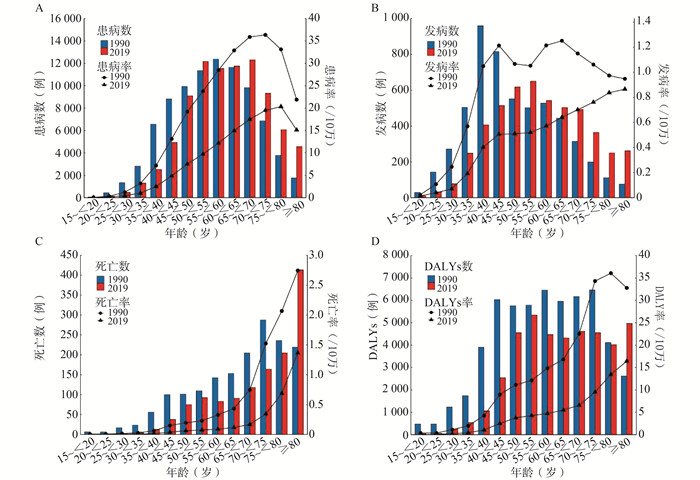-
摘要:
目的 分析1990―2019年中国煤工尘肺(coal workers’ pneumoconiosis, CWP)的疾病负担水平及其变化趋势。 方法 利用2019年全球疾病负担研究(Global Burden of Disease Study, GBD 2019)数据库,提取中国CWP的患病、发病与死亡者例数和特征信息,以及伤残调整寿命年(disability adjusted life year, DALYs)等疾病负担指标,分析CWP的疾病负担状况、年龄性别分布及时间变化趋势,并与全球人群进行对比。 结果 1990―2019年中国CWP的患病人数从87 555例降至86 296例,降幅为1.44%;发病人数从5 450例降至4 974例,降幅为8.73%;死亡人数从1 661例降至1 302例,降幅为21.61%;DALYs从57 206.70人年降至41 359.25人年,降幅为27.70%。中国CWP的年龄标化患病率、发病率、死亡率和DALYs率均呈下降趋势,平均年度变化百分比(average annual percentage change, AAPC)分别为-2.75%、-2.53%、-3.67%和-3.73%。中国CWP造成的疾病负担主要集中在男性。相较于1990年,2019年中国有更多高龄工人现患、新发或死于CWP。1990―2019年中国CWP的各项年龄标化率指标均高于全球同期水平,差异均有统计学意义(均有P < 0.001)。 结论 中国CWP引起的疾病负担整体呈下降趋势,表明中国CWP的防治取得了一定成效,但发病例数仍维持在较高水平,且各项年龄标化率指标始终高于全球同期水平,提示需要大力加强CWP的防控。 Abstract:Objective To analyze the level of disease burden and temporal trend of coal workers' pneumoconiosis (CWP) in China from 1990 to 2019. Methods The detailed data on CWP extracted from the database of the Global Burden of Disease Study 2019 (GBD 2019) was used to evaluate the disease burden and temporal trend of CWP in the Chinese population. The data included prevalent cases, incident cases, death cases, and indicators concerning disease burden such as disability-adjusted life years (DALYs). Results In China, prevalent cases of CWP decreased by 1.44% from 87 555 in 1990 to 86 296 in 2019; incident cases of CWP decreased by 8.73% from 5 450 in 1990 to 4 974 in 2019; deaths of CWP decreased by 21.61% from 1 661 in 1990 to 1 302 in 2019; DALYs of CWP decreased by 27.70% from 57 206.70 person-years in 1990 to 41 359.25 person-years in 2019. The age-standardized prevalence, incidence, mortality, and DALY rates of CWP in China decreased since 1990, with AAPCs of -2.75%, -2.53%, -3.67%, and -3.73%, respectively. And the disease burden of CWP was mainly caused by male groups. Compared with 1990, more elderly workers in China in 2019 suffered from or died of CWP. The age-standardized indicators of CWP in China were all higher than those globally from 1990 to 2019, and the differences were statistically significant (all P < 0.001). Conclusions The disease burden caused by CWP in China showed a downward trend in general, indicating that the prevention and control of CWP in China had obtained certain achievements. However, the incident cases of CWP in China remained at a high level, and the age-standardized indicators were still higher than those globally. Therefore, more efforts are needed to pay attention to the prevention and control of CWP in China. -
Key words:
- Coal workers' pneumoconiosis /
- Disease burden /
- Temporal trend
-
表 1 1990年和2019年中国CWP患病、发病、死亡及疾病负担情况
Table 1. Prevalence, incidence, mortality, and disease burden of CWP in China in 1990 and 2019
指标 1990年(95% UI值) 2019年(95% UI值) 变化幅度(%) 患病人数(例) 87 555(68 429~108 803) 86 296(67 454~106 862) -1.44 发病人数(例) 5 450(4 419~6 665) 4 974(3 976~6 263) -8.73 死亡人数(例) 1 661(542~2 518) 1 302(708~2 209) -21.61 DALYs(人年) 57 206.70(26 316.43~81 535.81) 41 359.25(28 064.25~62 580.63) -27.70 YLDs(人年) 13 041.01(8 074.15~19 301.47) 13 305.85(8 284.65~19 818.05) 2.03 YLLs(人年) 44 165.69(13 773.30~68 448.66) 28 053.40(15 692.66~49 125.46) -36.48 标化患病率(/10万) 9.15(7.19~11.34) 4.15(3.27~5.11) -54.64 标化发病率(/10万) 0.52(0.42~0.64) 0.25(0.21~0.31) -51.92 标化死亡率(/10万) 0.21(0.08~0.32) 0.07(0.04~0.12) -66.67 标化DALYs率(/10万) 6.26(2.92~8.74) 2.06(1.39~3.09) -67.09 标化YLDs率(/10万) 1.36(0.85~2.00) 0.64(0.40~0.95) -52.94 标化YLLs率(/10万) 4.90(1.53~7.45) 1.42(0.79~2.43) -71.02 注:DALYs:伤残调整寿命年;YLDs:伤残损失寿命年;YLLs:过早死亡损失寿命年。 表 2 1990―2019年全球和中国CWP各项年龄标化率指标的Joinpoint分析
Table 2. Joinpoint analysis of the age-standardized indicators of CWP worldwide and in China from 1990 to 2019
指标 年份分段1 年份分段2 年份分段3 1990―2019年 年份(年) APC(%) 年份(年) APC(%) 年份(年) APC(%) AAPC(%) 95% CI值 中国 年龄标化患病率 1990―2000 1.00 a 2000―2005 -8.24 a 2005―2019 -3.36 a -2.75 a -3.16~-2.34 年龄标化发病率 1990―2000 -0.01 2000―2005 -6.67 a 2005―2019 -2.78 a -2.53 a -2.82~-2.23 年龄标化死亡率 1990―2005 -2.56 a 2005―2008 -10.0 a 2008―2019 -3.39 a -3.67 a -4.23~-3.11 年龄标化DALYs率 1990―2003 -2.50 a 2003―2008 -7.47 a 2008―2019 -3.45 a -3.73 a -3.88~-3.58 年龄标化YLDs率 1990―2000 1.03 a 2000―2005 -7.94 a 2005―2019 -3.22 a -2.62 a -3.01~-2.22 年龄标化YLLs率 1990―2005 -3.27 a 2005―2009 -9.10 a 2009―2019 -3.08 a -4.03 a -4.43~-3.63 全球 年龄标化患病率 1990―2000 1.20 a 2000―2004 -8.30 a 2004―2019 -3.05 a -2.36 a -2.83~-1.88 年龄标化发病率 1990―2000 0.13 2000―2004 -6.57 a 2004―2019 -2.82 a -2.34 a -2.67~-2.01 年龄标化死亡率 1990―2003 -3.82 a 2003―2009 -6.37 a 2009―2019 -2.79 a -4.00 a -4.16~-3.84 年龄标化DALYs率 1990―2001 -3.34 a 2001―2009 -5.79 a 2009―2019 -3.05 a -3.93 a -4.03~-3.83 年龄标化YLDs率 1990―2000 1.24 a 2000―2004 -7.97 a 2004―2019 -2.94 a -2.24 a -2.69~-1.79 年龄标化YLLs率 1990―2004 -4.25 a 2004―2009 -6.91 a 2009―2019 -2.98 a -4.28 a -4.43~-4.12 注:a表示P < 0.05;APC:年度变化百分比;AAPC:平均年度变化百分比;DALYs:伤残调整寿命年;YLLs:过早死亡损失寿命年;YLDs:伤残损失寿命年。 -
[1] 贺佑国, 刘文革, 李艳强. 世界煤炭工业发展综论[J]. 中国煤炭, 2021, 47(1): 126-135. DOI: 10.19880/j.cnki.ccm.2021.01.019.He YG, Liu WG, Li YQ. Overview of world coal industry development[J]. China Coal, 2021, 47(1): 126-135. DOI: 10.19880/j.cnki.ccm.2021.01.019. [2] 孙贵范. 职业卫生与职业医学[M]. 第7版. 北京: 人民卫生出版社, 2012: 179-184.Sun GF. Occupational health and occupational medicine[M]. 7rd ed. Beijing: People's Medical Publishing House, 2012: 179-184. [3] 毛翎, 彭莉君, 王焕强. 尘肺病治疗中国专家共识(2018年版)[J]. 环境与职业医学, 2018, 35(8): 677-689. DOI: 10.13213/j.cnki.jeom.2018.18437.Mao L, Peng LJ, Wang HQ. Consensus of Chinese experts on pneumoconiosis treatment (2018)[J]. J Environ Occup Med, 2018, 35(8): 677-689. DOI: 10.13213/j.cnki.jeom.2018.18437. [4] Xi Z, Jiang M, Yang J, et al. Experimental study on advantages of foam-sol in coal dust control[J]. Process Safety and Environmental Protection, 2014, 92(6): 637-644. DOI: 10.1016/j.psep.2013.11.004. [5] National Health Commission of the People's Republic of China. The National Occupational Disease Report of 2016[EB/OL]. (2017-12-28)[2022-06-22]. http://www.nhc.gov.cn/jkj/s5899t/201712/c46227a95f054f5fa75a40e4db05bb37.shtml. [6] Shi P, Xing X, Xi S, et al. Trends in Global, Regional and National incidence of pneumoconiosis caused by different aetiologies: an analysis from the Global Burden of Disease Study 2017[J]. Occup Environ Med, 2020, 77(6): 407-414. DOI: 10.1136/oemed-2019-106321. [7] GBD 2019 Diseases and Injuries Collaborators. Global burden of 369 diseases and injuries in 204 countries and territories, 1990-2019: a systematic analysis for the Global Burden of Disease Study 2019[J]. Lancet, 2020, 396(10258): 1204-1222. DOI: 10.1016/S0140-6736(20)30925-9. [8] 朱晓俊, 牛东升, 王鸿飞, 等. 1990年至2017年中国人群煤工尘肺的疾病负担分析[J]. 中国工业医学杂志, 2019, 32(5): 356-361. DOI: 10.13631/j.cnki.zggyyx.2019.05.005.Zhu XJ, Niu DS, Wang HF, et al. Analysis on disease burden of coal workers pneumoconiosis in Chinese population from 1990 to 2017[J]. Chinese J Ind Med, 2019, 32(5): 356-361. DOI: 10.13631/j.cnki.zggyyx.2019.05.005. [9] 国家健康委员会规划发展与信息化司. 2020年我国卫生健康事业发展统计公报[J]. 中国病毒病杂志, 2021, 11(5): 321-329. DOI: 10.16505/j.2095-0136.2021.0034.Department of Planning, Development and Informatization Technology, National Health Commission of the People's Republic of China. Statistical bulletin of China's health development in 2020[J]. Chin J Viral Dis, 2021, 11(5): 321-329. DOI: 10.16505/j.2095-0136.2021.0034. [10] Almberg KS, Friedman LS, Rose CS, et al. Progression of coal workers' pneumoconiosis absent further exposure[J]. Occup Environ Med, 2020, 77(11): 748-751. DOI: 10.1136/oemed-2020-106466. [11] Wang D, Liang R, Yang M, et al. Incidence and disease burden of coal workers' pneumoconiosis worldwide, 1990-2019: evidence from the Global Burden of Disease Study 2019[J]. Eur Respir J, 2021, 58(5): 2101669. DOI: 10.1183/13993003.01669-2021. [12] Zosky GR, Hoy RF, Silverstone EJ, et al. Coal workers' pneumoconiosis: an Australian perspective[J]. Med J Aust, 2016, 204(11): 414-418. DOI: 10.5694/mja16.00357. [13] Parihar YS, Patnaik JP, Nema BK, et al. Coal workers' pneumoconiosis: a study of prevalence in coal mines of eastern Madhya Pradesh and Orissa states of India[J]. Ind Health, 1997, 35(4): 467-473. DOI: 10.2486/indhealth.35.467. [14] 煤矿作业场所职业病危害防治规定[J]. 国家安全生产监督管理总局国家煤矿安全监察局公告, 2015, (3): 5-16.Regulations on prevention and control of occupational disease hazards in coal mine workplaces[J]. Gazette of the State Administration of Work Safety and the State Administration of Coal Mine Safety, 2015, (3): 5-16. [15] 中华人民共和国国家卫生和计划生育委员会. GBZ 188-2014职业健康监护技术规范[S]. 北京: 中国标准出版社, 2014.National Health and Family Planning Commission of the People's Republic of China. Guideline of Occupational Health Surveillance GBZ 188-2014[S]. Beijing: Standards Press of China, 2014. [16] L. Fedotov, 薄梅花. ILO/WHO全球消除矽肺的国际规划[J]. 工业卫生与职业病, 1998, 24(1): 16-17. DOI: 10.13692/j.cnki.gywsyzyb.1998.01.005.L. Fedotov, Bo MH. The ILO/WHO international program on global elimination of silicosis[J]. Ind Hlth Occup Dis, 1998, 24(1): 16-17. DOI: 10.13692/j.cnki.gywsyzyb.1998.01.005. [17] International Labour Organization (ILO). Occupational health: silicosis[EB/OL]. (2018-07-05)[2021-12-20]. http://www.ilo.org/safework/areasofwork/occupational-health/WCMS_108566/lang--en/index.htm. [18] Petsonk EL, Rose C, Cohen R. Coal mine dust lung disease. New lessons from old exposure[J]. Am J Respir Crit Care Med, 2013, 187(11): 1178-1185. DOI: 10.1164/rccm.201301-0042CI. -





 下载:
下载:


